

Compact Muon Solenoid
LHC, CERN
| CMS-HIN-19-009 ; CERN-EP-2020-141 | ||
| Studies of charm and beauty hadron long-range correlations in pp and pPb collisions at LHC energies | ||
| CMS Collaboration | ||
| 15 September 2020 | ||
| Phys. Lett. B 813 (2021) 136036 | ||
| Abstract: Measurements of the second Fourier harmonic coefficient ($v_2$) of the azimuthal distributions of prompt and nonprompt ${\mathrm{D^0}}$ mesons (the latter coming from beauty hadron decays) produced in pp and pPb collisions are presented. The data samples are collected by the CMS experiment at nucleon-nucleon center-of-mass energies of 13 and 8.16 TeV, respectively. In high multiplicity pp collisions, $v_2$ signals for prompt charm hadrons are reported for the first time, and are found to be comparable to those for light-flavor hadron species over a transverse momentum (${p_{\mathrm{T}}}$) range of 2-6 GeV. Compared at similar event multiplicities, the prompt ${\mathrm{D^0}}$ meson $v_2$ values in pp and pPb collisions are similar in magnitude. The $v_2$ values for open beauty hadrons are extracted for the first time via nonprompt ${\mathrm{D^0}}$ mesons in pPb collisions. For ${p_{\mathrm{T}}}$ in the range of 2-5 GeV, the results suggest that $v_2$ for nonprompt ${\mathrm{D^0}}$ mesons are smaller than those for prompt ${\mathrm{D^0}}$ mesons. These new measurements indicate a positive charm hadron $v_2$ in pp collisions and suggest a mass dependence in $v_2$ between charm and beauty hadrons in the pPb system. These results provide insights into the origin of heavy-flavor quark collectivity in small systems. | ||
| Links: e-print arXiv:2009.07065 [hep-ex] (PDF) ; CDS record ; inSPIRE record ; HepData record ; CADI line (restricted) ; | ||
| Figures | |
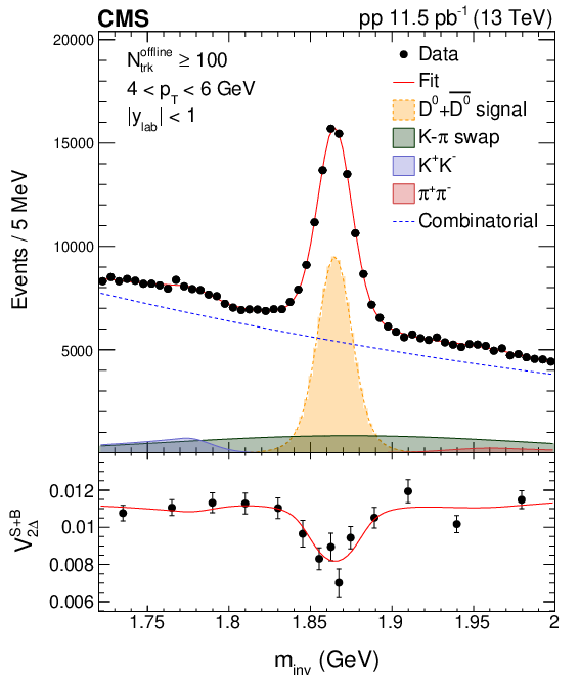
png pdf |
Figure 1:
Example of fits to the invariant mass spectrum and $V_{2\Delta}^{S+B}(m_{\text {inv}})$, for the BDT prompt-trained sample in pp collisions. |
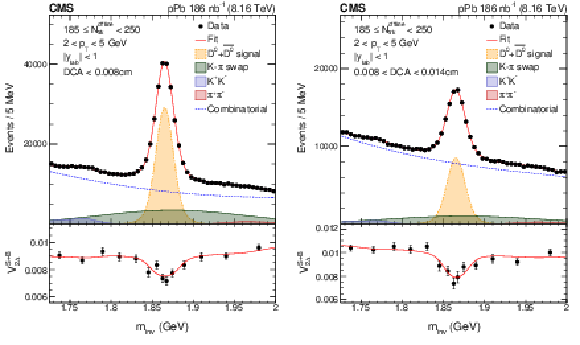
png pdf |
Figure 2:
Example of fits to the invariant mass spectrum and $V_{2\Delta}^{S+B}(m_{\text {inv}})$, for the BDT nonprompt-trained sample in pPb collisions. The left plot shows the fit for $\text {DCA} < $ 0.008 cm and the right plot is for 0.008 $ < \text {DCA} < $ 0.014 cm. |
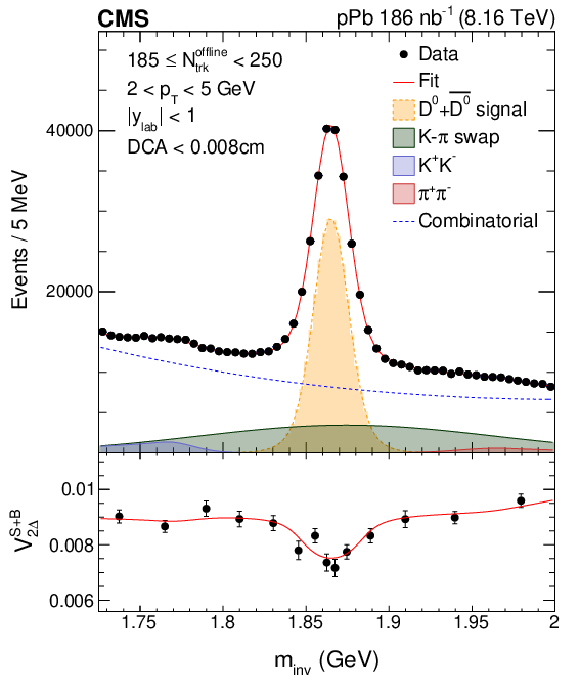
png pdf |
Figure 2-a:
Example of fit to the invariant mass spectrum and $V_{2\Delta}^{S+B}(m_{\text {inv}})$, for the BDT nonprompt-trained sample in pPb collisions. The plot shows the fit for $\text {DCA} < $ 0.008 cm. |
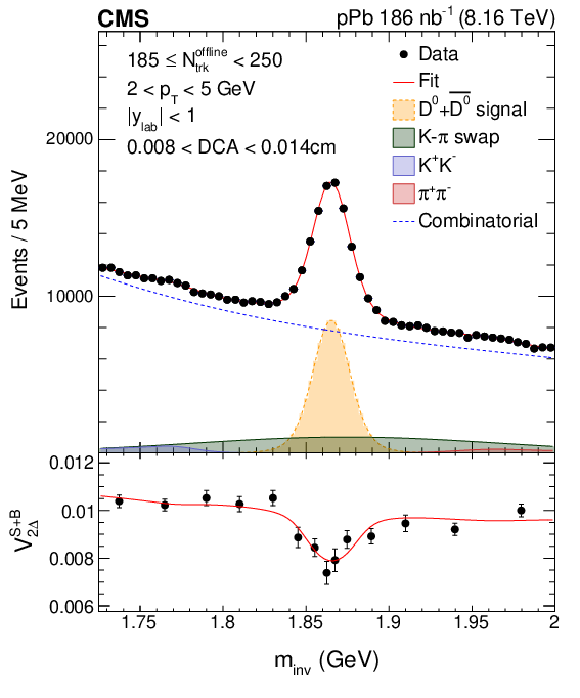
png pdf |
Figure 2-b:
Example of fit to the invariant mass spectrum and $V_{2\Delta}^{S+B}(m_{\text {inv}})$, for the BDT nonprompt-trained sample in pPb collisions. The plot shows the fit for 0.008 $ < \text {DCA} < $ 0.014 cm. |
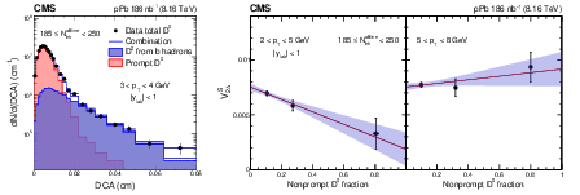
png pdf |
Figure 3:
Left: example of template fit to the ${\mathrm{D^0}}$ meson DCA distribution in the ${p_{\mathrm {T}}}$ interval 3-4 GeV for events with 185 $ \leq {N_\text {trk}^\text {offline}} < $ 250 of pPb collisions. Right: inclusive ${\mathrm{D^0}}$ $V_{2\Delta}^{S}$ values from the three DCA regions as a function of the corresponding nonprompt ${\mathrm{D^0}}$ fraction, for 2 $ < {p_{\mathrm {T}}} < $ 5 GeV and 5 $ < {p_{\mathrm {T}}} < $ 8 GeV. The red line is a linear fit to $V_{2\Delta}^{S}$ data. |
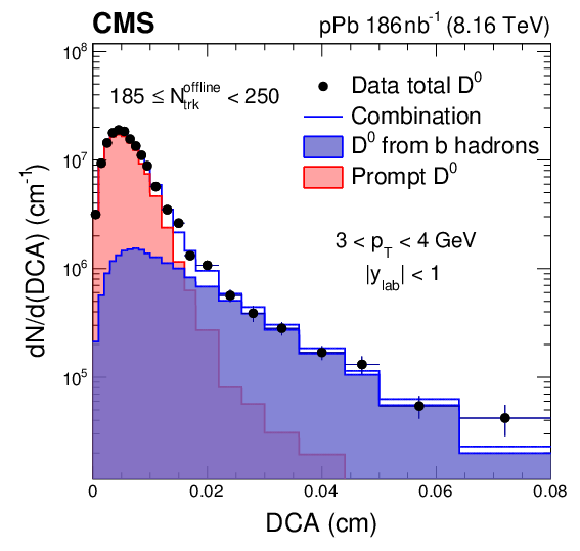
png pdf |
Figure 3-a:
Example of template fit to the ${\mathrm{D^0}}$ meson DCA distribution in the ${p_{\mathrm {T}}}$ interval 3-4 GeV for events with 185 $ \leq {N_\text {trk}^\text {offline}} < $ 250 of pPb collisions. |
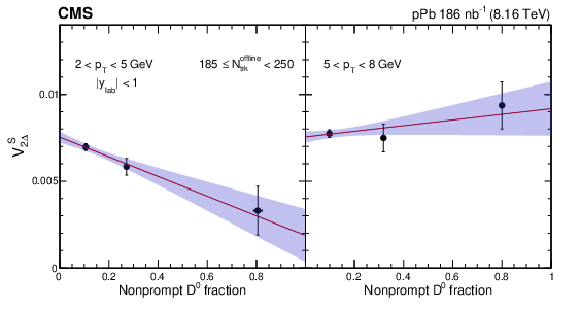
png pdf |
Figure 3-b:
Inclusive ${\mathrm{D^0}}$ $V_{2\Delta}^{S}$ values from the three DCA regions as a function of the corresponding nonprompt ${\mathrm{D^0}}$ fraction, for 2 $ < {p_{\mathrm {T}}} < $ 5 GeV and 5 $ < {p_{\mathrm {T}}} < $ 8 GeV. The red line is a linear fit to $V_{2\Delta}^{S}$ data. |
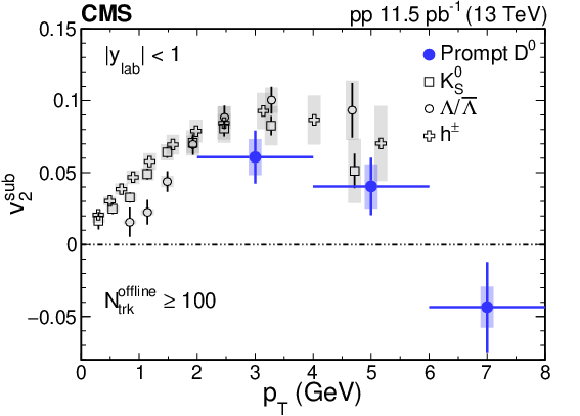
png pdf |
Figure 4:
Results of $v_2^{\text {sub}}$ for prompt $ {\mathrm{D^0}}$ mesons, as a function of ${p_{\mathrm {T}}}$ for $ {| y_{\text {lab}} |} < $ 1, with $ {N_\text {trk}^\text {offline}} \geq $ 100 in pp collisions at $ {\sqrt {s}} = $ 13 TeV. Published data for charged particles, ${\mathrm{K^0_S}}$ mesons and $\Lambda$ baryons are also shown for comparison [19]. The vertical bars correspond to the statistical uncertainties, while the shaded areas denote the systematic uncertainties. The horizontal bars represent the width of the ${p_{\mathrm {T}}}$ bins. |
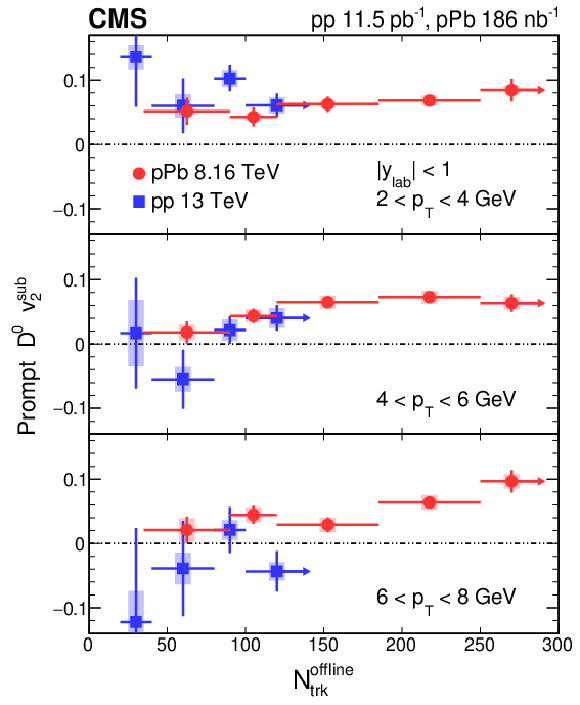
png pdf |
Figure 5:
Results of $v_2^{\text {sub}}$ for prompt $ {\mathrm{D^0}}$ mesons, as a function of event multiplicity for three different ${p_{\mathrm {T}}}$ ranges, with $ {| y_{\text {lab}} |} < $ 1 in pp collisions at $ {\sqrt {s}} = $ 13 TeV and pPb collisions at $ {\sqrt {\smash [b]{s_{_{\mathrm {NN}}}}}} = $ 8.16 TeV. The vertical bars correspond to statistical uncertainties, while the shaded areas denote the systematic uncertainties. The y-axis is zoomed in to better display the data; the uncertainties are symmetric with respect to their central values. The horizontal bars represent the width of the ${N_\text {trk}^\text {offline}}$ bins. The right-most points with right-hand arrows correspond to $ {N_\text {trk}^\text {offline}} \geq $ 100 for pp collisions and $ {N_\text {trk}^\text {offline}} \geq $ 250 for pPb collisions. The $v_2^{\text {sub}}$ values in pPb collisions with 185 $\leq {N_\text {trk}^\text {offline}} < $ 250 are measured in different ${p_{\mathrm {T}}}$ ranges from Ref. [57] and are found to be consistent with Ref. [57]. |

png pdf |
Figure 6:
Results of $v_2^{\text {sub}}$ for prompt and nonprompt $ {\mathrm{D^0}}$ mesons, as well as ${\mathrm{K^0_S}}$ mesons, $\Lambda$ baryons for $ {| y_{\text {lab}} |} < $ 1, and prompt $\mathrm{J}/\psi $ mesons for 1.2 $ < {| y_{\text {lab}} |} < $ 2.4, as functions of ${p_{\mathrm {T}}}$ with 185 $\leq {N_\text {trk}^\text {offline}} < $ 250 in pPb collisions at $ {\sqrt {\smash [b]{s_{_{\mathrm {NN}}}}}} = $ 8.16 TeV [57,59]. The vertical bars correspond to statistical uncertainties, while the shaded areas denote the systematic uncertainties. The horizontal bars represent the width of the nonprompt $ {\mathrm{D^0}}$ ${p_{\mathrm {T}}}$ bins. The dashed, dash-dotted, and solid lines, show the theoretical calculations of prompt ${\mathrm{D^0}}$, $\mathrm{J}/\psi$, and nonprompt $ {\mathrm{D^0}}$ mesons, respectively, within the CGC framework [61,77]. |
| Tables | |

png pdf |
Table 1:
Summary of systematic uncertainties on $v_2^{\text {sub}}$. The ranges of systematic uncertainties correspond to the ${p_{\mathrm {T}}}$ ranges of ${\mathrm{D^0}}$ mesons. |
| Summary |
| The first measurements of elliptic azimuthal anisotropies for prompt ${\mathrm{D^0}}$ mesons in proton-proton (pp) collisions at center-of-mass energy $\sqrt{s} = $ 13 TeV, and for nonprompt ${\mathrm{D^0}}$ mesons from beauty hadron decays in proton-lead (pPb) collisions at nucleon-nucleon center-of-mass energy ${\sqrt {\smash [b]{s_{_{\mathrm {NN}}}}}} = $ 8.16 TeV are presented. In pp collisions with multiplicities of ${N_\text {trk}^\text {offline}} \geq $100, the second Fourier harmonic coefficient ($v_2$) of the azimuthal distributions for prompt ${\mathrm{D^0}}$ mesons are measured over the transverse momentum (${p_{\mathrm{T}}}$) range of 2-8 GeV, with indications of positive $v_2$ signals over the ${p_{\mathrm{T}}}$ range of 2-4 GeV. These values are found to be comparable (or slightly smaller) to those of light-flavor hadron species. At similar event multiplicities, the prompt ${\mathrm{D^0}}$ meson $v_2$ signals in pp and pPb collisions are found to be comparable in magnitude. The $v_2$ values of open beauty hadrons are extracted for the first time via non-prompt ${\mathrm{D^0}}$ mesons in pPb collisions, with magnitudes smaller than those for prompt ${\mathrm{D^0}}$ mesons for ${p_{\mathrm{T}}} \sim 2$-5 GeV. The new measurements of charm hadron $v_2$ in the pp system and the indications of mass dependence of heavy-flavor hadron $v_2$ in the pPb system provide insights into the origin of heavy-flavor quark collectivity in small colliding systems. |
| References | ||||
| 1 | STAR Collaboration | Elliptic flow in Au+Au collisions at $ {\sqrt {\smash [b]{s_{_{\mathrm {NN}}}}}} = $ 130 GeV | PRL 86 (2001) 402 | nucl-ex/0009011 |
| 2 | PHENIX Collaboration | Elliptic flow of identified hadrons in Au+Au collisions at $ {\sqrt {\smash [b]{s_{_{\mathrm {NN}}}}}} = $ 200 GeV | PRL 91 (2003) 182301 | nucl-ex/0305013 |
| 3 | STAR Collaboration | Distributions of charged hadrons associated with high transverse momentum particles in pp and Au+Au collisions at $ {\sqrt {\smash [b]{s_{_{\mathrm {NN}}}}}} = $ 200 GeV | PRL 95 (2005) 152301 | nucl-ex/0501016 |
| 4 | PHOBOS Collaboration | System size dependence of cluster properties from two- particle angular correlations in Cu+Cu and Au+Au collisions at $ {\sqrt {\smash [b]{s_{_{\mathrm {NN}}}}}} = $ 200 GeV | PRC 81 (2010) 024904 | 0812.1172 |
| 5 | ALICE Collaboration | Elliptic flow of charged particles in Pb-Pb collisions at 2.76 TeV | PRL 105 (2010) 252302 | 1011.3914 |
| 6 | CMS Collaboration | Measurement of the elliptic anisotropy of charged particles produced in PbPb collisions at nucleon-nucleon center-of-mass energy = 2.76 TeV | PRC 87 (2013) 014902 | CMS-HIN-10-002 1204.1409 |
| 7 | J.-Y. Ollitrault | Anisotropy as a signature of transverse collective flow | PRD 46 (1992) 229 | |
| 8 | U. Heinz and R. Snellings | Collective flow and viscosity in relativistic heavy-ion collisions | Ann. Rev. Nucl. Part. Sci. 63 (2013) 123 | 1301.2826 |
| 9 | C. Gale, S. Jeon, and B. Schenke | Hydrodynamic modeling of heavy-ion collisions | Int. J. Mod. Phys. A 28 (2013) 1340011 | 1301.5893 |
| 10 | PHOBOS Collaboration | High transverse momentum triggered correlations over a large pseudorapidity acceptance in Au+Au collisions at $ {\sqrt {\smash [b]{s_{_{\mathrm {NN}}}}}} = $ 200 GeV | PRL 104 (2010) 062301 | 0903.2811 |
| 11 | STAR Collaboration | Long range rapidity correlations and jet production in high energy nuclear collisions | PRC 80 (2009) 064912 | 0909.0191 |
| 12 | CMS Collaboration | Long-range and short-range dihadron angular correlations in central PbPb collisions at a nucleon-nucleon center of mass energy of 2.76 TeV | JHEP 07 (2011) 076 | CMS-HIN-11-001 1105.2438 |
| 13 | CMS Collaboration | Centrality dependence of dihadron correlations and azimuthal anisotropy harmonics in PbPb collisions at $ {\sqrt {\smash [b]{s_{_{\mathrm {NN}}}}}} = $ 2.76 TeV | EPJC 72 (2012) 2012 | CMS-HIN-11-006 1201.3158 |
| 14 | ATLAS Collaboration | Measurement of the azimuthal anisotropy for charged particle production in $ {\sqrt {\smash [b]{s_{_{\mathrm {NN}}}}}} = $ 2.76 TeV lead-lead collisions with the ATLAS detector | PRC 86 (2012) 014907 | 1203.3087 |
| 15 | CMS Collaboration | Studies of azimuthal dihadron correlations in ultra-central PbPb collisions at $ {\sqrt {\smash [b]{s_{_{\mathrm {NN}}}}}} = $ 2.76 TeV | JHEP 02 (2014) 088 | CMS-HIN-12-011 1312.1845 |
| 16 | CMS Collaboration | Observation of long-range near-side angular correlations in proton-proton collisions at the LHC | JHEP 09 (2010) 091 | CMS-QCD-10-002 1009.4122 |
| 17 | ATLAS Collaboration | Observation of long-range elliptic azimuthal anisotropies in $ \sqrt{s}= $ 13 and 2.76 TeV pp collisions with the ATLAS detector | PRL 116 (2016) 172301 | 1509.04776 |
| 18 | CMS Collaboration | Measurement of long-range near-side two-particle angular correlations in pp collisions at $ \sqrt{s} = $ 13 TeV | PRL 116 (2016) 172302 | CMS-FSQ-15-002 1510.03068 |
| 19 | CMS Collaboration | Evidence for collectivity in pp collisions at the LHC | PLB 765 (2017) 193 | CMS-HIN-16-010 1606.06198 |
| 20 | ATLAS Collaboration | Measurement of azimuthal anisotropy of muons from charm and bottom hadrons in pp collisions at $ \sqrt{s}= $ 13 TeV with the ATLAS detector | PRL 124 (2020) 082301 | 1909.01650 |
| 21 | CMS Collaboration | Observation of long-range near-side angular correlations in proton-lead collisions at the LHC | PLB 718 (2013) 795 | CMS-HIN-12-015 1210.5482 |
| 22 | ALICE Collaboration | Long-range angular correlations on the near and away side in $ \mathrm{pPb}\ $ collisions at $ {\sqrt {\smash [b]{s_{_{\mathrm {NN}}}}}} = $ 5.02 TeV | PLB 719 (2013) 29 | 1212.2001 |
| 23 | ATLAS Collaboration | Observation of associated near-side and away-side long-range correlations in $ {\sqrt {\smash [b]{s_{_{\mathrm {NN}}}}}} = $ 5.02 TeV proton-lead collisions with the ATLAS detector | PRL 110 (2013) 182302 | 1212.5198 |
| 24 | LHCb Collaboration | Measurements of long-range near-side angular correlations in $ {\sqrt {\smash [b]{s_{_{\mathrm {NN}}}}}} = $ 5 TeV proton-lead collisions in the forward region | PLB 762 (2016) 473 | 1512.00439 |
| 25 | ALICE Collaboration | Long-range angular correlations of pi, K and p in p-Pb collisions at $ {\sqrt {\smash [b]{s_{_{\mathrm {NN}}}}}} = $ 5.02 TeV | PLB 726 (2013) 164 | 1307.3237 |
| 26 | CMS Collaboration | Long-range two-particle correlations of strange hadrons with charged particles in pPb and PbPb collisions at LHC energies | PLB 742 (2015) 200 | CMS-HIN-14-002 1409.3392 |
| 27 | CMS Collaboration | Evidence for collective multi-particle correlations in pPb collisions | PRL 115 (2015) 012301 | CMS-HIN-14-006 1502.05382 |
| 28 | ATLAS Collaboration | Measurement of multi-particle azimuthal correlations in pp, p+Pb and low-multiplicity Pb+Pb collisions with the ATLAS detector | EPJC 77 (2017) 428 | 1705.04176 |
| 29 | ATLAS Collaboration | Measurement of long-range multiparticle azimuthal correlations with the subevent cumulant method in pp and p+Pb collisions with the ATLAS detector at the CERN Large Hadron Collider | PRC 97 (2018) 024904 | 1708.03559 |
| 30 | PHENIX Collaboration | Measurement of long-range angular correlations and azimuthal anisotropies in high-multiplicity p+Au collisions at $ {\sqrt {\smash [b]{s_{_{\mathrm {NN}}}}}} = $ 200 GeV | PRC 95 (2017) 034910 | 1609.02894 |
| 31 | PHENIX Collaboration | Creation of quark-gluon plasma droplets with three distinct geometries | NP 15 (2019) 214 | 1805.02973 |
| 32 | STAR Collaboration | Long-range pseudorapidity dihadron correlations in d+Au collisions at $ {\sqrt {\smash [b]{s_{_{\mathrm {NN}}}}}} = $ 200 GeV | PLB 747 (2015) 265 | 1502.07652 |
| 33 | PHENIX Collaboration | Measurements of elliptic and triangular flow in high-multiplicity $ ^{3} $He+Au collisions at $ {\sqrt {\smash [b]{s_{_{\mathrm {NN}}}}}} = $ 200 GeV | PRL 115 (2015) 142301 | 1507.06273 |
| 34 | PHENIX Collaboration | Measurements of multiparticle correlations in d+Au collisions at 200, 62.4, 39, and 19.6 GeV and p+Au collisions at 200 GeV and implications for collective behavior | PRL 120 (2018) 062302 | 1707.06108 |
| 35 | K. Dusling, W. Li, and B. Schenke | Novel collective phenomena in high-energy proton-proton and proton-nucleus collisions | Int. J. Mod. Phys. E 25 (2016) 1630002 | 1509.07939 |
| 36 | Schlichting, Soren and Tribedy, Prithwish | Collectivity in small collision systems: An initial-state perspective | Adv. High Energy Phys. 2016 (2016) 8460349 | 1611.00329 |
| 37 | J. L. Nagle and W. A. Zajc | Small system collectivity in relativistic hadronic and nuclear collisions | Ann. Rev. Nucl. Part. Sci. 68 (2018) 211 | 1801.03477 |
| 38 | A. Badea et al. | Measurements of two-particle correlations in $ \mathrm{e^+e^-} $ collisions at 91 GeV with ALEPH archived data | PRL 123 (2019) 212002 | 1906.00489 |
| 39 | ZEUS Collaboration | Two-particle azimuthal correlations as a probe of collective behaviour in deep inelastic ep scattering at HERA | JHEP 04 (2020) 070 | 1912.07431 |
| 40 | S. Voloshin and Y. Zhang | Flow study in relativistic nuclear collisions by Fourier expansion of azimuthal particle distributions | Z. Phys. C 70 (1996) 665 | hep-ph/9407282 |
| 41 | B. H. Alver, C. Gombeaud, M. Luzum, and J.-Y. Ollitrault | Triangular flow in hydrodynamics and transport theory | PRC 82 (2010) 034913 | 1007.5469 |
| 42 | B. Schenke, S. Jeon, and C. Gale | Elliptic and triangular flow in event-by-event D=3+1 viscous hydrodynamics | PRL 106 (2011) 042301 | 1009.3244 |
| 43 | Z. Qiu, C. Shen, and U. Heinz | Hydrodynamic elliptic and triangular flow in Pb-Pb collisions at $ {\sqrt {\smash [b]{s_{_{\mathrm {NN}}}}}} = $ 2.76 TeV | PLB 707 (2012) 151 | 1110.3033 |
| 44 | B. Alver and G. Roland | Collision geometry fluctuations and triangular flow in heavy-ion collisions | PRC 81 (2010) 054905 | 1003.0194 |
| 45 | L. He et al. | Anisotropic parton escape is the dominant source of azimuthal anisotropy in transport models | PLB 753 (2016) 506 | 1502.05572 |
| 46 | C. Bierlich, G. Gustafson, L. Lonnblad, and H. Shah | The Angantyr model for heavy-ion collisions in PYTHIA8 | JHEP 10 (2018) 134 | 1806.10820 |
| 47 | A. Kurkela, U. A. Wiedemann, and B. Wu | Flow in AA and pA as an interplay of fluid-like and non-fluid like excitations | EPJC 79 (2019) 965 | 1905.05139 |
| 48 | A. Andronic et al. | Heavy-flavour and quarkonium production in the LHC era: from proton-proton to heavy-ion collisions | EPJC 76 (2016) 107 | 1506.03981 |
| 49 | X. Dong, Y.-J. Lee, and R. Rapp | Open heavy-flavor production in heavy-ion collisions | Ann. Rev. Nucl. Part. Sci. 69 (2019) 417 | 1903.07709 |
| 50 | PHENIX Collaboration | Energy loss and flow of heavy quarks in Au+Au collisions at $ {\sqrt {\smash [b]{s_{_{\mathrm {NN}}}}}} = $ 200 GeV | PRL 98 (2007) 172301 | nucl-ex/0611018 |
| 51 | STAR Collaboration | Measurement of $ {\mathrm{D^0}} $ azimuthal anisotropy at midrapidity in Au+Au collisions at $ {\sqrt {\smash [b]{s_{_{\mathrm {NN}}}}}} = $ 200 GeV | PRL 118 (2017) 212301 | 1701.06060 |
| 52 | ALICE Collaboration | Azimuthal anisotropy of D meson production in Pb-Pb collisions at $ {\sqrt {\smash [b]{s_{_{\mathrm {NN}}}}}} = $ 2.76 TeV | PRC 90 (2014) 034904 | 1405.2001 |
| 53 | ALICE Collaboration | D-meson azimuthal anisotropy in midcentral Pb-Pb collisions at $ {\sqrt {\smash [b]{s_{_{\mathrm {NN}}}}}}= $ 5.02 TeV | PRL 120 (2018) 102301 | 1707.01005 |
| 54 | CMS Collaboration | Measurement of prompt $ {\mathrm{D^0}} $ meson azimuthal anisotropy in Pb-Pb collisions at $ {\sqrt {\smash [b]{s_{_{\mathrm {NN}}}}}} = $ 5.02 TeV | PRL 120 (2018) 202301 | CMS-HIN-16-007 1708.03497 |
| 55 | CMS Collaboration | Suppression and azimuthal anisotropy of prompt and nonprompt $ \mathrm{J}/\psi $ production in PbPb collisions at $ {\sqrt {\smash [b]{s_{_{\mathrm {NN}}}}}} = $ 2.76 TeV | EPJC 77 (2017) 252 | CMS-HIN-14-005 1610.00613 |
| 56 | ALICE Collaboration | J/$ \psi $ elliptic flow in Pb-Pb collisions at $ {\sqrt {\smash [b]{s_{_{\mathrm {NN}}}}}}= $ 5.02 TeV | PRL 119 (2017) 242301 | 1709.05260 |
| 57 | CMS Collaboration | Elliptic flow of charm and strange hadrons in high-multiplicity pPb collisions at $ {\sqrt {\smash [b]{s_{_{\mathrm {NN}}}}}} = $ 8.16 TeV | PRL 121 (2018) 082301 | CMS-HIN-17-003 1804.09767 |
| 58 | ALICE Collaboration | Search for collectivity with azimuthal J/$ \psi $-hadron correlations in high multiplicity p-Pb collisions at $ {\sqrt {\smash [b]{s_{_{\mathrm {NN}}}}}} = $ 5.02 and 8.16 TeV | PLB 780 (2018) 7 | 1709.06807 |
| 59 | CMS Collaboration | Observation of prompt $ \mathrm{J}/\psi $ meson elliptic flow in high-multiplicity pPb collisions at $ {\sqrt {\smash [b]{s_{_{\mathrm {NN}}}}}} = $ 8.16 TeV | PLB 791 (2019) 172 | CMS-HIN-18-010 1810.01473 |
| 60 | X. Du and R. Rapp | In-medium charmonium production in proton-nucleus collisions | JHEP 03 (2019) 015 | 1808.10014 |
| 61 | C. Zhang et al. | Elliptic flow of heavy quarkonia in pA collisions | PRL 122 (2019) 172302 | 1901.10320 |
| 62 | CMS Collaboration | Description and performance of track and primary-vertex reconstruction with the CMS tracker | JINST 9 (2014) P10009 | CMS-TRK-11-001 1405.6569 |
| 63 | CMS Collaboration | The CMS experiment at the CERN LHC | JINST 3 (2008) S08004 | CMS-00-001 |
| 64 | CMS Collaboration | The CMS trigger system | JINST 12 (2017) P01020 | CMS-TRG-12-001 1609.02366 |
| 65 | CMS Collaboration | CMS luminosity measurement using 2016 proton-nucleus collisions at nucleon-nucleon center-of-mass energy of 8.16 TeV | CMS-PAS-LUM-17-002 | CMS-PAS-LUM-17-002 |
| 66 | CMS Collaboration | Constraints on the chiral magnetic effect using charge-dependent azimuthal correlations in $ \mathrm{pPb} $ and pbpb collisions at the CERN Large Hadron Collider | PRC 97 (2018) 044912 | CMS-HIN-17-001 1708.01602 |
| 67 | CMS Collaboration | Observation of correlated azimuthal anisotropy fourier harmonics in pp and p+Pb collisions at the LHC | PRL 120 (2018) 092301 | CMS-HIN-16-022 1709.09189 |
| 68 | H. Voss, A. Hocker, J. Stelzer, and F. Tegenfeldt | TMVA --- the toolkit for multivariate data analysis | in XIth International Workshop on Advanced Computing and Analysis Techniques in Physics Research (ACAT), p. 40 2009 | physics/0703039 |
| 69 | T. Sjostrand et al. | An introduction to PYTHIA 8.2 | CPC 191 (2015) 159 | 1410.3012 |
| 70 | CMS Collaboration | Event generator tunes obtained from underlying event and multiparton scattering measurements | EPJC 76 (2016) 155 | CMS-GEN-14-001 1512.00815 |
| 71 | T. Pierog et al. | EPOS LHC: Test of collective hadronization with data measured at the CERN Large Hadron Collider | PRC 92 (2015) 034906 | 1306.0121 |
| 72 | CMS Collaboration | Multiplicity and transverse momentum dependence of two- and four-particle correlations in $ \mathrm{pPb}\ $ and $ \mathrm{PpPb}\ $ collisions | PLB 724 (2013) 213 | CMS-HIN-13-002 1305.0609 |
| 73 | M. J. Oreglia | A study of the reactions $\psi' \to \gamma\gamma \psi$ | PhD thesis, Stanford University, 1980 SLAC Report SLAC-R-236, see A | |
| 74 | M. Nahrgang et al. | Elliptic and triangular flow of heavy flavor in heavy-ion collisions | PRC 91 (2015) 014904 | 1410.5396 |
| 75 | M. He, R. J. Fries, and R. Rapp | Heavy flavor at the Large Hadron Collider in a strong coupling approach | PLB 735 (2014) 445 | 1401.3817 |
| 76 | J. Xu, J. Liao, and M. Gyulassy | Bridging soft-hard transport properties of quark-gluon plasmas with CUJET3.0 | JHEP 02 (2016) 169 | 1508.00552 |
| 77 | C. Zhang et al. | Collectivity of heavy mesons in proton-nucleus collisions | PRD 102 (2020) 034010 | 2002.09878 |

|
Compact Muon Solenoid LHC, CERN |

|

|

|

|

|

|